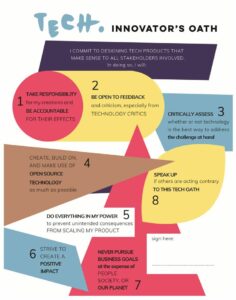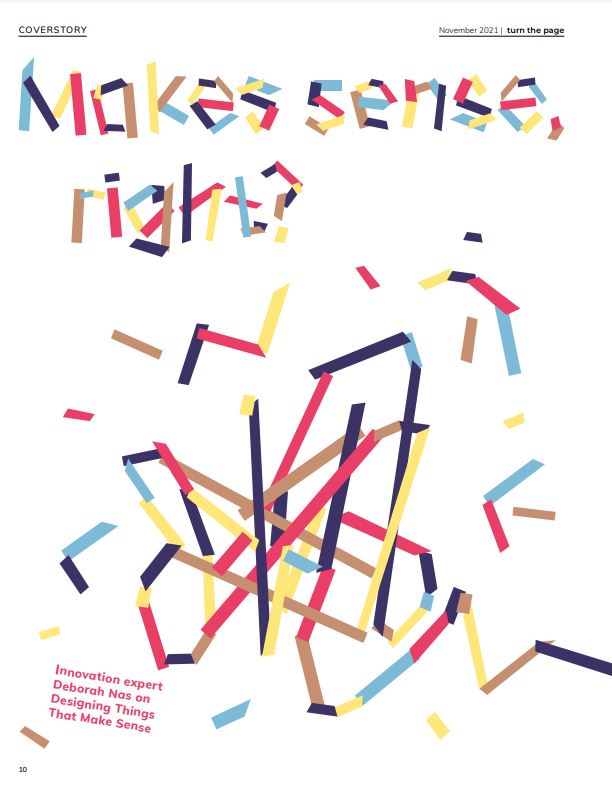
“When it comes to new technologies, not everybody is equally enthusiastic”, says professor and innovator expert Deborah Nas. We sat down with her and discussed how to make innovations stick.
text by Eva Le Navenec and Frank van Beek | layout by Eva Le Navenec | special thanks to Deborah Nas
Having studied Industrial Design Engineering (IDE) at the TU Delft, Deborah Nas co-founded a strategic innovation agency that focuses on the innovation’s fuzzy front-end. Currently, she has a broad portfolio of activities. Deborah is a consultant, a supervisory board member, and a public speaker on innovation and technology. Moreover, she is a professor of Strategic Design for Technology-based Innovation at the faculty of IDE. “I focus on strategic questions around applying new technologies, and I have a special interest in technology adoption and resistance against technology.” This interest sparked the creation of her first book, ‘Design Things That Make Sense’.
78
You wrote your book using your knowledge and personal experience. How would you describe the end result?
“The book is a very hands-on tool to help designers and students create better tech products. Tech products are products that depend on technologies for their core functionality. If you look at tech products, many of them simply do not make sense to consumers. Technology is utilised to create lots of features that people do not really need nor value.” To help innovators focus on customer needs, Deborah defined 37 design strategies.
According to Deborah, there are two critical success factors for designing great tech products. The first is offering strong product benefits. The other is minimizing possible resistance against technological features in your product. Resistance is generally due to the drawbacks of new technologies and the change they enforce. “If your concept makes use of technology to combine benefits that were difficult to unite before, you are on to something”, says Deborah.
“Tesla is a good example: they combine sustainability, performance, and future-proof in their value proposition. Besides choosing the key benefits wisely, it works to include many other benefits. Do not talk about them too much, though, as this will muddle your positioning. Incorporating them in your product design leads to a better user experience and, therefore, happier users. In this respect, Tesla is a rare case: they include 17 of 24 design strategies to strengthen benefits and 12 of 13 design strategies to mitigate resistance. I have not seen any other case like this.”
To further explain the importance of her design strategies, Deborah first describes the implications of using Agile Innovation methods like Scrum or Lean Startup in product innovation. These methods are based on iteratively performed short cycles of designing. This helps the team to continuously adapt and change the plans, achieving flexibility and cost-efficiency.
She stresses that, despite the upsides of Agile Innovation methods, user-centred innovation is lacking in Agile Innovation teams. Part of the problem is that agile teams often skip consumer research, assuming that consumers do not know what they want. “This is a misconception. Sometimes people cannot express what they want, but they do experience problems and have needs. As a designer, you observe, test, and probe to connect the dots and find that hidden opportunity.”
“Most of the start-up teams do not have a designer on board; they are primarily techies. When they do have a designer on board, it is often an inexperienced one. The result is that they immediately start building a product and need many iterations to find the right product-market fit. Most start-ups run out of money before ever finding product-market fit and die in vain.”

For whom specifically did you write the book? Is it more useful for professional designers or for students?
“The book is for all innovators involved in designing and developing tech products, many of whom are not trained as designers. Designers are innovators, but most innovators are not designers. This book offers a practical methodology to insert design thinking into agile innovation processes.”
The design strategies are also helpful for students to fast track their design projects, according to Deborah. For experienced designers, the book serves more as a reference guide, and it can help start-up founders get to product-market fit faster. Product owners, product managers, and innovation managers can utilize this book to help their teams become better innovators.
Let us discuss credibility for a moment. How did you come up with these strategies?
“It took me a few years. I thought it would be easier, to be honest.” Deborah started off with diving deeply into literature, but that was not enough. Apart from papers often being narrowly focused, many also proved to be outdated, she states. “Research done on the adoption of smart products twenty years ago was done in a very different context than the one we find ourselves in today. New technological innovations trigger new forms of resistance. For example, twenty years ago, people were much less worried about privacy.”
That is why Deborah decided to add case studies to her research. “I analysed many products and tried to deconstruct their success or failure. I found small pieces of the puzzle everywhere.” Based on her 25-years of experience and her findings from literature and case studies, she defined 37 design strategies. In the last two years of the research, she teamed up with Anna Filippi, a recently graduated IDE strategic product designer who worked with Deborah on this book one day per week while working at a design agency the other days of the week. In a series of workshops, they iterated the strategies together with other innovations experts.
“We approached it as a design project, and—pointing at the book—this is the result.”
Privacy is an interesting point of discussion. How should we deal with privacy in technology-based innovations?
“That is always a bit of a struggle; ideally, you would want to go for ‘Privacy by Design’, in which you follow seven principles to make sure that data cannot be traced back to an individual. However, if you want to provide the benefit of personalized services, you need to link data to individual users.” Deborah explains that thinking about seemingly opposing values in an early stage, and coming up with solutions to accommodate them all, is crucial for designing great tech products. To aid this process, each design strategy in her book is supported by tactics and examples to help innovators understand their options. For example, by storing and processing data locally, you can achieve data privacy and achieve personalization.

Other ways to achieve data privacy is by using tactics such as ‘collect less data,’ ‘make data end-to-end encrypted,’ or ‘offer consumers detailed control over data sharing’. The latter is one of the tactics Apple uses. They offer their users quite a detailed level of which data can be shared with whom. In reality, though, most consumers do not make use of the opportunity to change these settings. Only consumers with a strong concern for privacy make an effort. “In design, you’re continuously making trade-offs; offering a detailed level of control often lowers ease of use. It is up to designers to find the right balance by deciding what they find important from an ethical stance and then weighing this against desired functionality, ease of use, and commercial interests.”
You have described powerful and effective strategies to design things that consumers love. However, innovators might use these design strategies to simply sell more products and stimulate consumerism. What is your view on this?
“As designers, we have the responsibility to consider our impact on the world. IDE students should already think about this and ask themselves questions like ‘What type of impact do I want to make?’ ‘What is my ethical stance on consumerism?’ I’m convinced that if you use the design strategies with the right mindset, you’ll design products that people will use for a long time. Today, it happens way too often that you buy a product and, after starting to use it, you discover that it is just a shitty product. It turns out to be very user-unfriendly or does not do what you thought it would do. As a result, you quickly replace it with another product. If we design better products, we waste fewer resources and get happier and more loyal customers that use their products for longer.”
“Of course, you can use the design strategies to design a product that sells better, aiming to sell as many products as possible to the same consumer, but obviously you should not”. Deborah added the Tech Innovator’s Oath at the beginning of the book to make readers aware of their responsibility. “As a designer, you shape the world around you. You need to take responsibility for your creations and their effects. Unfortunately, tech products often have unintended side effects, so we have to think things through from the very beginning.”
Want to sign the oath? Or any questions about the book? Take a look at Deborah’s website: www.designthingsthatmakessense.com
Being close to Christmas, we have a special last question. What is one of the products that is on your Christmas list?
“I just pre-ordered one! They are headphones with woven-in neuro-sensors that measure your brain signals, to be released in May 2022. When you are listening to music while working, they will give insight into your concentration level and recommend when to take a break. When we link these headphones to the design strategies, we see that they use the design strategy ‘unlock new value’. They will give me insights into the types of music that help me concentrate, when I am the most productive, and how to improve productivity.”
Read Online
Note: this is a preview
